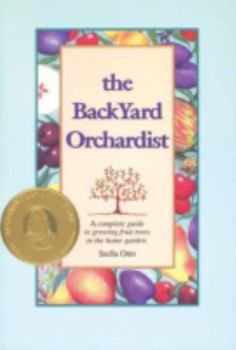The Backyard Orchardist: A Complete Guide to Growing Fruit Trees in the Home Garden
For every gardener desiring to add apples, pears, cherries, and other tree fruit to their landscape here are hints and solid information from a professional horticulturist and experienced fruit... This description may be from another edition of this product.
Format:Paperback
Language:English
ISBN:0963452037
ISBN13:9780963452030
Release Date:January 1995
Publisher:Otto Graphics
Length:250 Pages
Weight:0.96 lbs.
Dimensions:9.3" x 0.8" x 6.3"
Customer Reviews
5 ratings
great reference on fruit trees
Published by Thriftbooks.com User , 16 years ago
I have about 5 books on fruit trees and this is by far the best and most comprehensive. Only drawback is that they don't use real pictures.
Everything I need to know
Published by Thriftbooks.com User , 17 years ago
After killing a peach tree and three cherry trees, I decided I better try to find out what I did wrong. This book is pointing the error of my ways. It has all I need to know.
Growing fruit trees
Published by Thriftbooks.com User , 17 years ago
This book exceeded our expectations. We highly recommend it for anyone who wants to grow fruit for their own consumption. Other books we've tried to read were much too technical and always intended for commercial growers. Stella Otto's book is clear, concise, and chock-full of information. We loved it and feel confident we will now be able to better tend our 10 fruit trees.
Get Ready for Spring
Published by Thriftbooks.com User , 18 years ago
If you have found it difficult to move beyond dreaming about a backyard orchard, this book is such a powerhouse of information that you will confidently plant a pair of fruit trees knowing that they will not drown, succumb to drought or disease, and not be defoliated by Japanese beetles. You'll even know how to prune them so that the branches grow outward rather than straight up, thus allowing in the sunlight needed to ripen your fruit. Consider the chapters below, which the author has divided into 6 sections: Section 1: Getting started with fruit trees, includes chapters on fitting them into your landscape, selecting the right site by paying attention to climate, average minimum temperatures and hardiness, length of growing season, soil, moisture, sunlight, and space required. Did you know that cherry trees cannot have wet roots for longer than 24 hours or they will release cyanide and kill themselves? So cherry trees should be planted on a slope or hill with good drainage. Section 2: Fruit fundamental - growth habits of specific fruit trees includes chapters on Pome fruit (apples and pears) and Stone fruit (sweet & tart cherries, apricots, plums, aprium, pluots, peaches and nectarines). Section 3: Caring for your fruit trees includes chapters on nutrition and fertilizers, pruning, growing fruit trees in containers (so you can bring in, say, a fig tree inside for the winter), and flowering, fruiting, and thinning (many fruit trees will produce too many fruits and either their branches will break or the fruit will be very small, so you must thin the fruit on them). Section 4: Pests and Disease has chapters on insect pests, disease identification, insect and disease controls, and wildlife pests. Section 5: Harvest has a chapter on knowing when to pick and eat your yummy prize! Section 6 contains charts and lists of resources. The only caveat is the chapter on sweet cherries, which is 11 years old and a bit outdated because since then dwarf sweet cherries are the rage. They are grown on German Gisela 5 dwarfing rootstock or Russian dwarfing rootstock and produce a cherry tree no taller than 10 feet, which means they are easy to cover with netting so that the birds don't eat them up. With this book, you'll know what to expect with your orchard; knowledge is power. Get ready for Spring!
User-friendly. Hits all the bases
Published by Thriftbooks.com User , 24 years ago
The Backyard Orchardist by Stella Otto is filled with fruit growing information that is very easy for the hobbyist to implement. Equally important, the information is well organized and is exceptionally easy to find.Strengths:*The information is comprehensive.*The information is very specific. Example: The tables inform you as to which pesticides are most suitable for a given pest (cross referenced to a table of illustrations) and when to spray for them.*The information is both usable and generic. For example: The advice on fertilizing recommends that the grower adjust the amount of fertilizer to match a target annual growth rate (length of shoot extension). That technique compensates for differences in soil type, rootstock, cultivar, etc. Basically, it teaches the grower how to pay attention to their trees.Weaknesses:*Illustrations are more functional than artistic. Not always a drawback.*The very specific nature of the advice limits it. The book was published in 1995. The regulation status (and availability) of pesticides can change from year-to-year. New disease-resistant cultivars are released annually.*Lists of fruit cultivars will seem a little sketchy to the rabid fruit growing enthusiast.Summary:*Buy this book if you live in the area bounded by Maine, Montana, Colorado, and North Carolina and you can only afford one book on growing tree-fruits.*Do not buy this book if you want a "coffee-table book."






